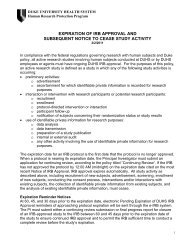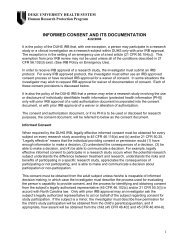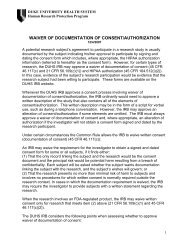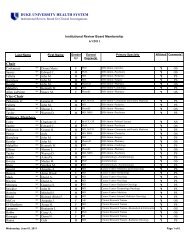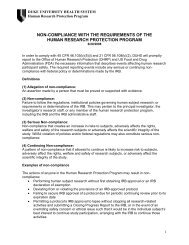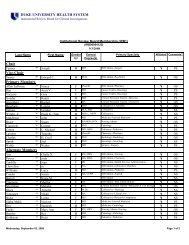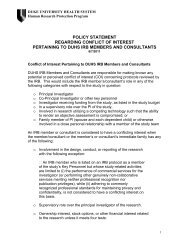expedited review procedure - Institutional Review Board - Duke ...
expedited review procedure - Institutional Review Board - Duke ...
expedited review procedure - Institutional Review Board - Duke ...
Create successful ePaper yourself
Turn your PDF publications into a flip-book with our unique Google optimized e-Paper software.
DUKE UNIVERSITY HEALTH SYSTEMHuman Research Protection ProgramEXPEDITED REVIEW PROCEDURE08/13/2008It is the policy of the <strong>Duke</strong> University Health System IRB (DUHS IRB) that qualifiedhuman subject research be <strong>review</strong>ed using the <strong>expedited</strong> <strong>procedure</strong> in accordancewith federal regulations. An <strong>expedited</strong> <strong>procedure</strong> refers to <strong>review</strong> of researchinvolving human subjects by the IRB Chair, Vice Chair or qualified IRB memberdesignee in accordance with 45 CFR 46.110 and 21 CFR 56.110.Background and DefinitionsNew and ongoing research activities that present no more than minimal risk tohuman subjects, and involve only <strong>procedure</strong>s listed in one or more of the followingcategories, or involve only minor changes in previously approved research duringthe period (one year or less) for which approval is authorized, may be <strong>review</strong>ed bythe DUHS IRB through the <strong>expedited</strong> <strong>review</strong> <strong>procedure</strong> authorized by 45 CFR46.110 and 21 CFR 56.110. In compliance with 45 CFR 46.110(b) and 21 CFR56.110(b), the <strong>review</strong> may be carried out by the IRB Chair or by an experienced<strong>review</strong>er designated by the IRB Chair from among the members of the IRB (referredto here as designee). An experienced member is one who has been an IRBmember for at least one year. Experienced members who are designated by theSenior Chair, in conjunction with the Executive Director, to conduct <strong>expedited</strong><strong>review</strong>s include, but are not limited to: Chairs, Vice Chairs, Executive Director, andDirector, IRB Education Programs. The Senior Chair in conjunction with theExecutive Director annually <strong>review</strong>s this list and updates it as needed, and IRB staffselect one <strong>review</strong>er from this list for each study to be <strong>review</strong>ed using the <strong>expedited</strong><strong>procedure</strong>. This <strong>review</strong>er receives and <strong>review</strong>s all material that a convened IRBwould receive were it to <strong>review</strong> the research.Whether for initial <strong>review</strong> or continuing <strong>review</strong>, the <strong>review</strong>er evaluates whether theresearch undergoing <strong>review</strong> using the <strong>expedited</strong> <strong>procedure</strong>:• Meets all applicability criteria.• Represents one or more approvable categories of research.• Designates which category(ies) of approval will apply to the research.The <strong>review</strong>er uses one of the following <strong>review</strong> checklists to determine that theresearch meets the regulatory criteria for approval:• Primary <strong>Review</strong>er Checklist - New Protocol• Primary <strong>Review</strong>er Checklist - Continuing <strong>Review</strong>• Primary <strong>Review</strong>er Checklist – Business Item / AmendmentFor the <strong>review</strong> of a modification to previously approved research, the <strong>review</strong>erdetermines that the modification represents a minor change as defined below.1
In <strong>review</strong>ing the research, the Chair/designee may exercise all of the authorities ofthe IRB except that the <strong>review</strong>er may not disapprove the research. For example, the<strong>review</strong>er may approve, require modifications to secure approval, or defer actionpending receipt of additional information from the investigator. However, a researchactivity may be disapproved only after <strong>review</strong> in accordance with the non-<strong>expedited</strong><strong>procedure</strong>s set forth in 45 CFR 46.108(b) and 21 CFR 56.108(c).Minimal risk means that the probability and magnitude of harm or discomfortanticipated in the research are not greater in and of themselves than those ordinarilyencountered in daily life or during the performance of routine physical orpsychological examinations or tests [45 CFR 46.102(i) and 21 CFR 56.102(i)]. TheDUHS IRB interprets this definition to encompass the <strong>procedure</strong> practiced by theDUHS IRB of regarding minimal risk as the risk encountered by a healthy person inthe course of normal daily living. This DUHS <strong>procedure</strong> is also consistent with thedefinition of minimal risk set forth in 45 CFR 46.303(d).A change is minor if it does not represent a material change in the research, i.e.,(a) the change does not adversely alter the overall risk/benefit ratio;(b) the change will not potentially adversely affect the willingness ofcurrent participants to remain in the study or the willingness ofpotential participants to enroll in the study;(c) the change will not diminish the scientific validity of the study,(d) any added revision or <strong>procedure</strong> involves no more than minimal risk tosubjects, and(e) any added <strong>procedure</strong> falls into one of the categories (1)-(7) of researchthat can be <strong>review</strong>ed using the <strong>expedited</strong> <strong>procedure</strong>.Applicability:Activities for Which the Use of the Expedited <strong>Review</strong> Procedure Is Permissible(A) Research activities that (1) present no more than minimal risk to human subjects,and (2) involve only <strong>procedure</strong>s listed in one or more of the following categories,may be <strong>review</strong>ed by the IRB through the <strong>expedited</strong> <strong>review</strong> <strong>procedure</strong>. The activitieslisted should not be deemed to be of minimal risk simply because they are includedon this list. Inclusion on this list merely means that the activity is eligible for <strong>review</strong>through the <strong>expedited</strong> <strong>review</strong> <strong>procedure</strong> when the specific circumstances of theproposed research involve no more than minimal risk to human subjects.(B) The categories in this list apply regardless of the age of subjects, except asnoted.(C) The <strong>expedited</strong> <strong>review</strong> <strong>procedure</strong> may not be used where identification of thesubjects and/or their responses would reasonably place them at risk of criminal orcivil liability or be damaging to the subjects’ financial standing, employability,insurability, reputation, or be stigmatizing, unless reasonable and appropriateprotections will be implemented so that risks related to invasion of privacy andbreach of confidentiality are no greater than minimal.2
(D) The <strong>expedited</strong> <strong>review</strong> <strong>procedure</strong> may not be used for classified researchinvolving human subjects.(E) Investigators are reminded that the standard requirements for informed consent(or its waiver, alteration, or exception) apply regardless of the type of <strong>review</strong>--<strong>expedited</strong> or convened--utilized by the IRB.(F) Categories one (1) through seven (7) below pertain to both initial and continuingIRB <strong>review</strong>.(A) Initial and Continuing <strong>Review</strong>As described in OHRP guidance (63 FR 60364-60367), dated November 9, 1998,the following categories of research may be <strong>review</strong>ed by the IRB through the<strong>expedited</strong> <strong>procedure</strong>. These categories are also available online at:http://www.hhs.gov/ohrp/humansubjects/guidance/<strong>expedited</strong>98.htm.(1) Clinical studies of drugs and medical devices only when condition (a) or (b) ismet:(a) Research on drugs for which an investigational new drug application (21CFR Part 312) is not required. (Note: Research on marketed drugs that significantlyincrease the risks or decreases the acceptability of the risks associated with the useof the product is not eligible for <strong>expedited</strong> <strong>review</strong>.)(b) Research on medical devices for which (i) an investigational deviceexemption application (21 CFR Part 812) is not required; or (ii) the medical device iscleared/approved for marketing and the medical device is being used in accordancewith its cleared/approved labeling.(2) Collection of blood samples by finger stick, heel stick, ear stick, or venipunctureas follows:(a) from healthy, non-pregnant adults who weigh at least 110 pounds. Forthese subjects, the amounts drawn may not exceed 550 ml in an 8 week period andcollection may not occur more frequently than 2 times per week; or(b) from other adults and children, considering the age, weight, and health ofthe subjects, the collection <strong>procedure</strong>, the amount of blood to be collected, and thefrequency with which it will be collected. For these subjects, the amount drawn maynot exceed the lesser of 50 ml or 3 ml per kg in an 8 week period and collection maynot occur more frequently than 2 times per week.(3) Prospective collection of biological specimens for research purposes bynoninvasive means.(4) Collection of data through noninvasive <strong>procedure</strong>s (not involving generalanesthesia or sedation) routinely employed in clinical practice, excluding <strong>procedure</strong>s3
involving x-rays or microwaves. Where medical devices are employed, they must becleared/approved for marketing. (Studies intended to evaluate the safety andeffectiveness of the medical device are not generally eligible for <strong>expedited</strong> <strong>review</strong>,including studies of cleared medical devices for new indications.)(5) Research involving materials (data, documents, records, or specimens) that havebeen collected, or will be collected solely for non-research purposes (such asmedical treatment or diagnosis).(6) Collection of data from voice, video, digital, or image recordings made forresearch purposes.(7) Research on individual or group characteristics or behavior (including, but notlimited to, research on perception, cognition, motivation, identity, language,communication, cultural beliefs or practices, and social behavior) or researchemploying survey, interview, oral history, focus group, program evaluation, humanfactors evaluation, or quality assurance methodologies.(8) Continuing <strong>review</strong> of research previously approved by the convened IRB asfollows:(a) where (i) the research is permanently closed to the enrollment of subjects;(ii) all subjects have completed all research-related interventions; and (iii) theresearch remains active only for long-term follow-up of subjects; or(b) where no subjects have been enrolled and no additional risks have beenidentified; or(c) where the remaining research activities are limited to data analysis.(9) Continuing <strong>review</strong> of research, not conducted under an investigational new drugapplication or investigational device exemption where categories two (2) througheight (8) do not apply but the IRB has determined and documented at a convenedmeeting that the research involves no greater than minimal risk and no additionalrisks have been identified.Research in any of these categories may require <strong>review</strong> at a convened meeting ofthe IRB if the circumstances of the proposed research involve more than minimalrisk.(B) Approval of Investigator’s Response to a Convened <strong>Board</strong>’sRequest for Changes following Initial or Continuing <strong>Review</strong>The IRB may use the <strong>expedited</strong> <strong>review</strong> <strong>procedure</strong> to approve an investigator’sresponse to a convened board’s request for minor changes following initial orcontinuing <strong>review</strong> of an IRB protocol. Examples of changes (a) that are not minor,and (b) that are minor are described below.(a) When IRB approval of a research project is contingent upon substantivechange/amplification/clarification/explanation/justification/simplification, the following<strong>procedure</strong>s apply:4
When the IRB asks substantive questions about the protocol/consent form orrequests additional information that is directly relevant to the IRB’sdetermination of whether the research meets the regulatory criteria forapproval (45 CFR 46.111 or 21 CFR 56.111), then approval of the proposedresearch must be deferred, pending subsequent <strong>review</strong> of the investigator’sresponse by the IRB at a convened meeting.Examples of board actions requiring <strong>review</strong> of the investigator’s response by theconvened board:• Request for additional information on pre-clinical or clinical experience withthe drug/device/biologic. This additional information is directly relevant to theboard’s determination of whether risks to subjects are reasonable in relationto anticipated benefits.• Request for justification and rationale for doing research biopsies in healthyvolunteers. The response has direct bearing on minimizing risks by using<strong>procedure</strong>s that do not unnecessarily expose subjects to risk.(b) However, the IRB may stipulate specific revisions requiring only simpleconcurrence by the investigator, or request additional information that is not relevantto the IRB’s determination of whether the revised research meets the regulatorycriteria for approval; these revisions are regarded as minor changes.If the investigator’s response is concordant with the stipulations, or the additionalinformation is provided as requested, the IRB Chair/designee may approve therevised protocol on behalf of the convened board using the <strong>expedited</strong> <strong>review</strong><strong>procedure</strong>. <strong>Board</strong> action to permit this would be to approve the protocol subject tothe required modifications being made.Examples of board actions permitting <strong>review</strong> of the investigator’s response using the<strong>expedited</strong> <strong>procedure</strong>:• Rather than asking the investigator to describe plans for monitoring the datato ensure the safety of subjects, the board determines what level ofmonitoring is appropriate and requires the investigator to incorporate thestipulated plan into the protocol.• Although there might be some ambiguity in the protocol regarding the agerange of subjects to be enrolled, the board determines that one or more ageranges would meet the regulatory requirements for approval. The investigatoris asked to specify which will be the criterion for eligibility, and if the choice fitswithin the IRB’s predetermined acceptable range, the protocol may beapproved using the <strong>expedited</strong> <strong>review</strong> <strong>procedure</strong>.5
• Although it is unclear whether results of genetic testing will be returned tosubjects, rather than asking the investigator to clarify, the board determineswhether results should be returned and the investigator is asked to concurwith the board’s decision.• To further minimize the risk to individual participants, the board requires thatthose with known history of a particular condition, for example known heartdisease, be excluded from participation.• To assist in the future <strong>review</strong> of a protocol, the IRB asks the investigator toadd specific information from the sponsor’s protocol to the IRB protocolsummary.(C) Minor Changes in Previously Approved ResearchFor research previously approved by a convened IRB, the IRB may use the<strong>expedited</strong> <strong>review</strong> <strong>procedure</strong> to <strong>review</strong> minor changes in previously approvedresearch during the period (one year or less) for which approval is authorized.Examples of this include:• Acknowledgement of an adverse event report that is determined not torepresent an unanticipated problem involving risks to subjects or others.• Initially determining (subject to confirmation by a convened IRB) that anadverse consequence of research participation represents an unanticipatedproblem involving risks to subjects or others.• Approving a waiver of consent/HIPAA authorization for ascertainment andrecruitment of potential subjects.The IRB may also use the <strong>expedited</strong> <strong>review</strong> <strong>procedure</strong> to <strong>review</strong> any change toresearch previously approved using the <strong>expedited</strong> <strong>procedure</strong>, as long as the changemeets the above definition of “minor”.Actions To Be Taken By The IRB Chair/DesigneeThe IRB Chair/designee is responsible for determining whether the research iseligible for <strong>review</strong> using the <strong>expedited</strong> <strong>procedure</strong>. The IRB Chair/designee, oncedetermining that the research meets the applicability criteria for <strong>review</strong> using the<strong>expedited</strong> <strong>procedure</strong>, then uses the listing of <strong>expedited</strong> <strong>review</strong> categories publishedin the Federal Register at 63 FR 60364-60367 (noted above) to guide him/her indetermining if the research fits within the applicable <strong>expedited</strong> <strong>review</strong> categories. Ifapplicable, the IRB Chair/designee also documents that the consent form includesthe basic elements of consent +/- HIPAA authorization or documents protocolspecificfindings permitting approval of a waiver or alteration of consent +/- HIPAAauthorization.6
If the proposed research is not eligible for <strong>review</strong> using the <strong>expedited</strong> <strong>procedure</strong>, theIRB Chair/designee requests that the research protocol be scheduled for <strong>review</strong> at aconvened IRB meeting.The IRB Chair/designee may consult another IRB member(s) or a non-IRB memberconsultant with special expertise in the scientific area or discipline or specialpopulation being studied; however the IRB Chair/designee is responsible for the<strong>review</strong> and approval of research using the <strong>expedited</strong> <strong>procedure</strong>. When a consultantis to be used, the IRB Chair/designee follows the policies and <strong>procedure</strong>s for use ofa consultant as described in DUHS IRB Use of Consultants.When the IRB Chair/designee requires modifications to secure approval or defersaction pending receipt of additional information, the investigator is notified in writingof the required modifications or additional information required for <strong>review</strong>. Theinvestigator is asked to submit a point-by-point response and revised documents tothe IRB.When received, the IRB Chair/designee <strong>review</strong>s the investigator’s response,including revised documents, and indicates whether the modifications have beenmade as requested and whether the protocol can receive final approval. The IRBChair/designee may continue to request additional modifications or information untilthe protocol is approved or referred for <strong>review</strong> at a convened meeting of the IRB.The IRB Chair/designee may use the Expedited <strong>Review</strong> Checklist to documentapproval and provide the basis for approving the protocol/protocol-associateddocument through the <strong>expedited</strong> <strong>review</strong> <strong>procedure</strong>. The IRB Chair/designee mayrequest additional information from the investigator to make this determination.Notification of IRB Approval Resulting From Use of the Expedited <strong>Review</strong>ProcedureThe investigator is notified of the outcome of a <strong>review</strong> that uses the <strong>expedited</strong><strong>procedure</strong>. This notification process is consistent with that described elsewhere forinitial or continuing <strong>review</strong>. If ancillary committee <strong>review</strong> is required, this <strong>review</strong> isprovided to the person performing the <strong>review</strong> using the <strong>expedited</strong> <strong>procedure</strong>, whichmust occur prior to final approval by the IRB <strong>review</strong>er.IRB members are informed of all research activities approved using the <strong>expedited</strong><strong>procedure</strong> by way of the report of <strong>expedited</strong> <strong>review</strong> activities. This report listing allnew and ongoing research activities approved using the <strong>expedited</strong> <strong>procedure</strong> isdistributed with the agenda and meeting materials for the next convened IRBmeeting following preparation of the report.7


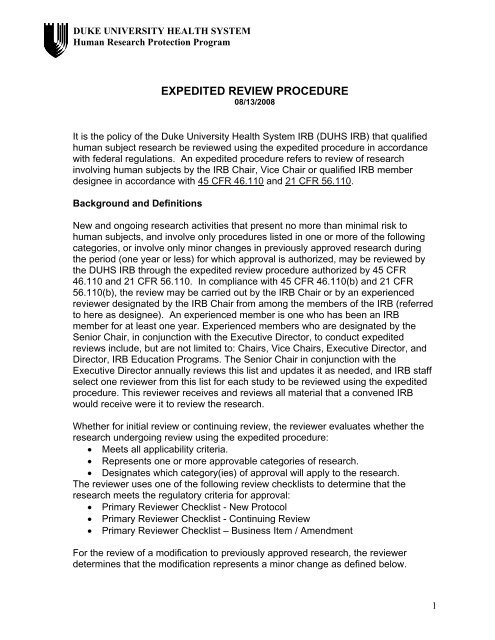
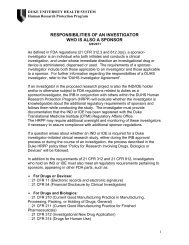

![Human Research Protection Program [Dr. Wesley Byerly]](https://img.yumpu.com/50293157/1/190x143/human-research-protection-program-dr-wesley-byerly.jpg?quality=85)
